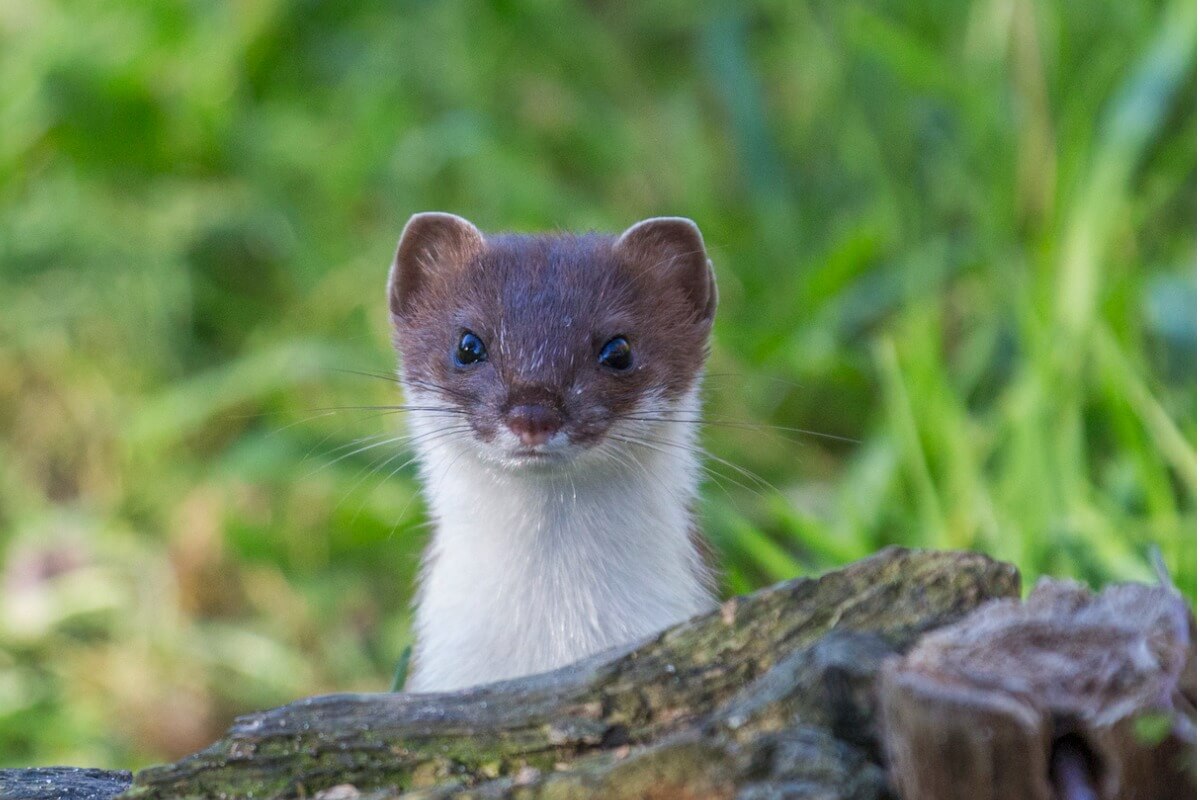Is it Possible to Have a Stoat as a Pet?

Stoats are quite small and looks rather adorable, which may give some people thoughts of wanting to adopt one as a pet. However, it’s a wild species and not recommended to have at home, as they’re fierce animals and haven’t gone through the domestication process of a dog or cat.
However, you could find yourself in the situation of finding a wounded or orphaned specimen and you may need to take it home until you can get it to a recovery center. Therefore, in this article, we’ll tell you all about the characteristics of a stoat and how to look after it if you can’t get it to a center right away.
Stoat characteristics
The body of the stoat (Mustela erminea) is about 30 centimeters (12 inches) long and doesn’t usually weigh more than half a kilogram. Its most striking feature is the change in color of its fur, which turns white in winter in specimens that live in cold areas.
This species is distributed in rural areas throughout Europe, the northern United States, Canada, and Greenland.
It’s an agile and efficient hunter, a great climber, and capable of getting into the burrows of its prey. In addition to this, it’s active both day and night, as it divides its rest into small naps. Its diet consists of a wide range of animals: rabbits and hares (despite them being larger than it), small rodents, birds, and reptiles, among others.
The stoat is in a conservation status of Least Concern (LC) according to the International Union for Conservation of Nature (IUCN) and is protected in several countries. In Spain, for example, it’s a native species of special interest, which means that its exploitation must be regulated so that it isn’t compromised.

Is it ethical to keep a stoat as a pet?
The answer is no, it certainly isn’t ethical to keep a stoat as a pet, nor is it advisable either. This opinion is based on several facts, which we’ll bring you below:
- Stoats haven’t gone through a process of domestication: This means that they haven’t developed any physical or mental characteristics that would allow it to live with humans without incurring their suffering.
- It’s a dangerous animal: To give you an idea, its hunting technique is based on grabbing its prey by the neck with a quick bite, killing them instantly. Stoats bite and do a lot of damage.
- If you buy one, it’s very likely to have been taken from the wild: In most parts of the world, stoat breeders are almost non-existent, so the sale is carried out with one that has been taken from its natural habitat.
- You could be committing a crime: Find out if it’s legal to keep them in your country. If you live in a European region, it most probably isn’t.
- It deserves to be free: Like any part of an ecosystem, the stoat plays a fundamental role in the balance of its environment. To deprive it of its freedom is to force it to live with suffering for the rest of its days, no matter how much love and dedication you give it.
It’s important to be aware that taking an animal home should be an act of responsibility, not whimsy. No matter how adorable a creature may be, it will always be better off in its natural habitat than in a closed environment, especially if it’s a solitary animal with a bite as dangerous as the stoat’s.
It’s impossible to give an undomesticated predator the necessary environmental enrichment in a domestic environment.
What do I do if I find an injured or orphaned stoat?
The most advisable action in these cases is to take the injured or orphaned animal to a wildlife recovery center, and not adopt the stoat as a pet. These facilities have everything the animal needs to help and heal it, and give it a chance to return to its habitat.
However, you may find yourself in the situation of having to take the mammal in for a day or two until you can get it to these centers, or perhaps you need to know how to handle it in order to take it to a veterinary center. For these cases, here are some general tips to help you:
- If it’s seriously injured, take it to an exotic animal veterinary center: They’ll have what it takes to save the stoat’s life, if it’s possible to do so. Once it’s stabilized, you or they can transfer it to a recovery center.
- Avoid handling it with your hands as much as possible: As we said earlier, stoats are slippery and bite hard. In addition, as wild animals, they can transmit diseases. Always use rigid plastic carriers and protective gloves if you have no choice but to catch the specimen.
- If it’s young, feed it with ferret milk in a syringe without a needle. The vet will tell you how much it needs. If it already has teeth, add some meat to its diet.
- Prepare a nest inside its cage or carrier for it to sleep in: You can use blankets or rags, depending on the temperature. Clean the area daily.

When you finally get it to the recovery center, be sure to cover the carrier with a cloth to reduce stress. The truth is that the stoat is a beautiful animal, especially as a baby, and you may be tempted to keep it as a pet if it still doesn’t have teeth, but you need to resist this temptation. It’s much more rewarding to save its life than to face an adulthood of dangerous biting and handling.
Stoats are quite small and looks rather adorable, which may give some people thoughts of wanting to adopt one as a pet. However, it’s a wild species and not recommended to have at home, as they’re fierce animals and haven’t gone through the domestication process of a dog or cat.
However, you could find yourself in the situation of finding a wounded or orphaned specimen and you may need to take it home until you can get it to a recovery center. Therefore, in this article, we’ll tell you all about the characteristics of a stoat and how to look after it if you can’t get it to a center right away.
Stoat characteristics
The body of the stoat (Mustela erminea) is about 30 centimeters (12 inches) long and doesn’t usually weigh more than half a kilogram. Its most striking feature is the change in color of its fur, which turns white in winter in specimens that live in cold areas.
This species is distributed in rural areas throughout Europe, the northern United States, Canada, and Greenland.
It’s an agile and efficient hunter, a great climber, and capable of getting into the burrows of its prey. In addition to this, it’s active both day and night, as it divides its rest into small naps. Its diet consists of a wide range of animals: rabbits and hares (despite them being larger than it), small rodents, birds, and reptiles, among others.
The stoat is in a conservation status of Least Concern (LC) according to the International Union for Conservation of Nature (IUCN) and is protected in several countries. In Spain, for example, it’s a native species of special interest, which means that its exploitation must be regulated so that it isn’t compromised.

Is it ethical to keep a stoat as a pet?
The answer is no, it certainly isn’t ethical to keep a stoat as a pet, nor is it advisable either. This opinion is based on several facts, which we’ll bring you below:
- Stoats haven’t gone through a process of domestication: This means that they haven’t developed any physical or mental characteristics that would allow it to live with humans without incurring their suffering.
- It’s a dangerous animal: To give you an idea, its hunting technique is based on grabbing its prey by the neck with a quick bite, killing them instantly. Stoats bite and do a lot of damage.
- If you buy one, it’s very likely to have been taken from the wild: In most parts of the world, stoat breeders are almost non-existent, so the sale is carried out with one that has been taken from its natural habitat.
- You could be committing a crime: Find out if it’s legal to keep them in your country. If you live in a European region, it most probably isn’t.
- It deserves to be free: Like any part of an ecosystem, the stoat plays a fundamental role in the balance of its environment. To deprive it of its freedom is to force it to live with suffering for the rest of its days, no matter how much love and dedication you give it.
It’s important to be aware that taking an animal home should be an act of responsibility, not whimsy. No matter how adorable a creature may be, it will always be better off in its natural habitat than in a closed environment, especially if it’s a solitary animal with a bite as dangerous as the stoat’s.
It’s impossible to give an undomesticated predator the necessary environmental enrichment in a domestic environment.
What do I do if I find an injured or orphaned stoat?
The most advisable action in these cases is to take the injured or orphaned animal to a wildlife recovery center, and not adopt the stoat as a pet. These facilities have everything the animal needs to help and heal it, and give it a chance to return to its habitat.
However, you may find yourself in the situation of having to take the mammal in for a day or two until you can get it to these centers, or perhaps you need to know how to handle it in order to take it to a veterinary center. For these cases, here are some general tips to help you:
- If it’s seriously injured, take it to an exotic animal veterinary center: They’ll have what it takes to save the stoat’s life, if it’s possible to do so. Once it’s stabilized, you or they can transfer it to a recovery center.
- Avoid handling it with your hands as much as possible: As we said earlier, stoats are slippery and bite hard. In addition, as wild animals, they can transmit diseases. Always use rigid plastic carriers and protective gloves if you have no choice but to catch the specimen.
- If it’s young, feed it with ferret milk in a syringe without a needle. The vet will tell you how much it needs. If it already has teeth, add some meat to its diet.
- Prepare a nest inside its cage or carrier for it to sleep in: You can use blankets or rags, depending on the temperature. Clean the area daily.

When you finally get it to the recovery center, be sure to cover the carrier with a cloth to reduce stress. The truth is that the stoat is a beautiful animal, especially as a baby, and you may be tempted to keep it as a pet if it still doesn’t have teeth, but you need to resist this temptation. It’s much more rewarding to save its life than to face an adulthood of dangerous biting and handling.
All cited sources were thoroughly reviewed by our team to ensure their quality, reliability, currency, and validity. The bibliography of this article was considered reliable and of academic or scientific accuracy.
- Armiño – Mustela erminea – Hábitat. (s. f.). Vertebrados Ibéricos. Recuperado 8 de diciembre de 2021, de http://www.vertebradosibericos.org/mamiferos/habitat/musermha.html
- Reid, F., Helgen, K. & Kranz, A. 2016. Mustela erminea. The IUCN Red List of Threatened Species 2016: e.T29674A45203335. https://dx.doi.org/10.2305/IUCN.UK.2016-1.RLTS.T29674A45203335.en. Downloaded on 08 December 2021.
- Doherty, T. S., Glen, A. S., Nimmo, D. G., Ritchie, E. G., & Dickman, C. R. (2016). Invasive predators and global biodiversity loss. Proceedings of the National Academy of Sciences, 113(40), 11261-11265.
This text is provided for informational purposes only and does not replace consultation with a professional. If in doubt, consult your specialist.








